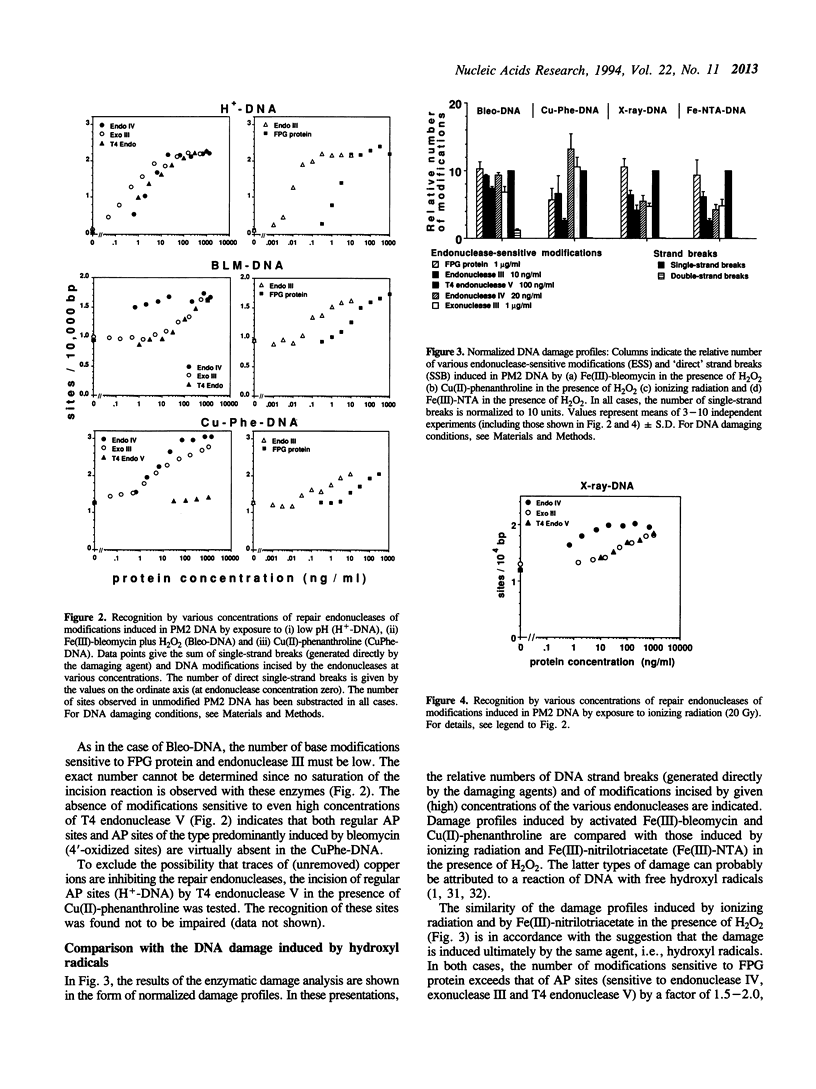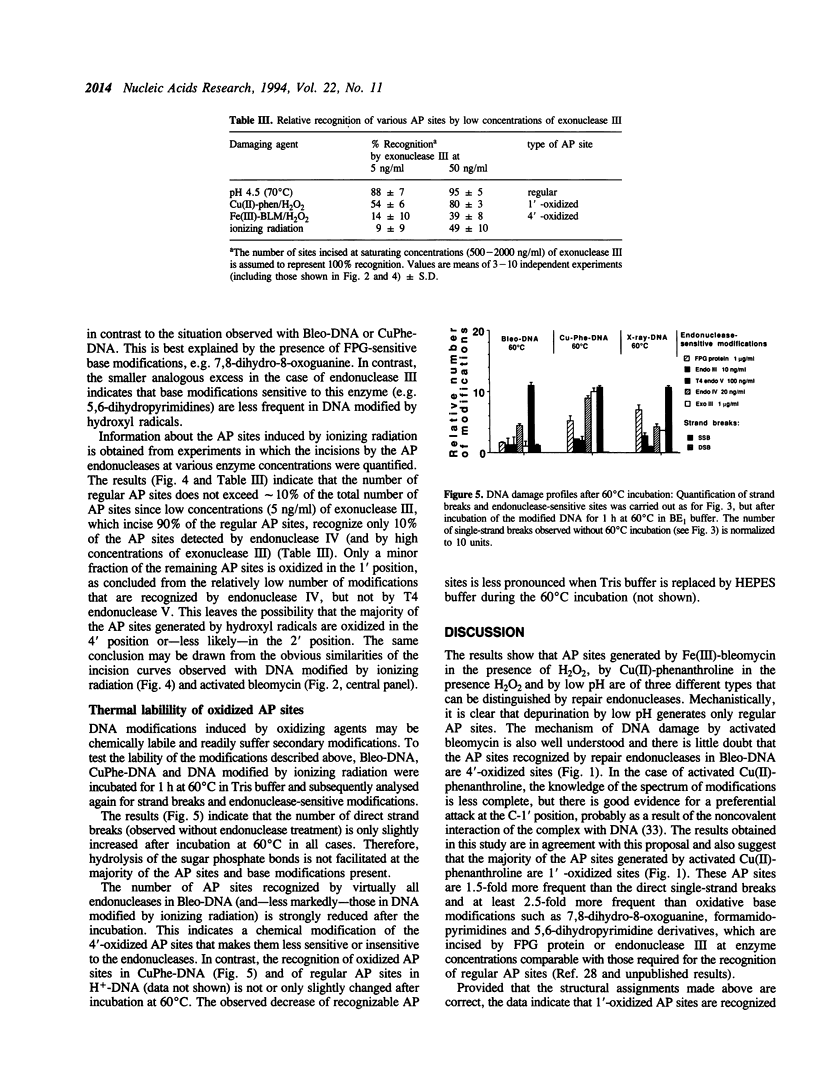Abstract
The recognition of 'regular' and 'oxidized' sites of base loss (AP sites) in DNA by various AP endonucleases was compared. Model substrates with regular AP sites (resulting from mere hydrolysis of the glycosylic bond) were produced by damaging bacteriophage PM2 DNA by exposure to low pH; those with AP sites oxidized at the C-4'- and C-1'-position of the sugar moiety by exposure to Fe(III)-bleomycin in the presence of H2O2 and to Cu(II)-phenanthroline in the presence of H2O2 and ethanol, respectively. The results confirmed that AP sites-together with single-strand breaks-are indeed the predominant type of DNA modification in all three cases. For the recognition of 4'-oxidized AP sites, a 400-fold higher concentration of Escherichia coli exonuclease III and between 5-fold and 50-fold higher concentrations of bacteriophage T4 endonuclease V, E. coli endonuclease III and E. coli FPG protein were required than for the recognition of regular AP sites. In contrast, the recognition of 4'-oxidized AP sites by E. coli endonuclease IV was effected by 4-fold lower concentrations than needed for regular AP sites. 1'-oxidized AP sites (generated by activated Cu(II)-phenanthroline) were recognized by endonuclease IV and exonuclease III only slightly (3-fold and 13-fold, respectively) less efficiently than regular AP sites. In contrast, there was virtually no recognition of 1'-oxidized AP sites by the enzymes which cleave at the 3' side of AP sites (T4 endonuclease V, endonuclease III and FPG protein). The described differences were exploited for the analysis of the DNA damage induced by hydroxyl radicals, generated by ionizing radiation or Fe(III)-nitrilotriacetate in the presence of H2O2. The results indicate that both regular and 1'-oxidized AP sites represent only minor fractions of the AP sites induced by hydroxyl radicals.
Full text
PDF





Selected References
These references are in PubMed. This may not be the complete list of references from this article.
- Aruoma O. I., Halliwell B., Gajewski E., Dizdaroglu M. Damage to the bases in DNA induced by hydrogen peroxide and ferric ion chelates. J Biol Chem. 1989 Dec 5;264(34):20509–20512. [PubMed] [Google Scholar]
- Asahara H., Wistort P. M., Bank J. F., Bakerian R. H., Cunningham R. P. Purification and characterization of Escherichia coli endonuclease III from the cloned nth gene. Biochemistry. 1989 May 16;28(10):4444–4449. doi: 10.1021/bi00436a048. [DOI] [PubMed] [Google Scholar]
- Boiteux S., O'Connor T. R., Lederer F., Gouyette A., Laval J. Homogeneous Escherichia coli FPG protein. A DNA glycosylase which excises imidazole ring-opened purines and nicks DNA at apurinic/apyrimidinic sites. J Biol Chem. 1990 Mar 5;265(7):3916–3922. [PubMed] [Google Scholar]
- Boiteux S. Properties and biological functions of the NTH and FPG proteins of Escherichia coli: two DNA glycosylases that repair oxidative damage in DNA. J Photochem Photobiol B. 1993 Jul;19(2):87–96. doi: 10.1016/1011-1344(93)87101-r. [DOI] [PubMed] [Google Scholar]
- Cunningham R. P., Weiss B. Endonuclease III (nth) mutants of Escherichia coli. Proc Natl Acad Sci U S A. 1985 Jan;82(2):474–478. doi: 10.1073/pnas.82.2.474. [DOI] [PMC free article] [PubMed] [Google Scholar]
- Dizdaroglu M. Measurement of radiation-induced damage to DNA at the molecular level. Int J Radiat Biol. 1992 Feb;61(2):175–183. doi: 10.1080/09553009214550791. [DOI] [PubMed] [Google Scholar]
- Doetsch P. W., Cunningham R. P. The enzymology of apurinic/apyrimidinic endonucleases. Mutat Res. 1990 Sep-Nov;236(2-3):173–201. doi: 10.1016/0921-8777(90)90004-o. [DOI] [PubMed] [Google Scholar]
- Epe B., Hegler J., Wild D. Identification of ultimate DNA damaging oxygen species. Environ Health Perspect. 1990 Aug;88:111–115. doi: 10.1289/ehp.9088111. [DOI] [PMC free article] [PubMed] [Google Scholar]
- Epe B., Pflaum M., Boiteux S. DNA damage induced by photosensitizers in cellular and cell-free systems. Mutat Res. 1993 May;299(3-4):135–145. doi: 10.1016/0165-1218(93)90091-q. [DOI] [PubMed] [Google Scholar]
- Epe B., Pflaum M., Häring M., Hegler J., Rüdiger H. Use of repair endonucleases to characterize DNA damage induced by reactive oxygen species in cellular and cell-free systems. Toxicol Lett. 1993 Apr;67(1-3):57–72. doi: 10.1016/0378-4274(93)90046-z. [DOI] [PubMed] [Google Scholar]
- Gajewski E., Aruoma O. I., Dizdaroglu M., Halliwell B. Bleomycin-dependent damage to the bases in DNA is a minor side reaction. Biochemistry. 1991 Mar 5;30(9):2444–2448. doi: 10.1021/bi00223a021. [DOI] [PubMed] [Google Scholar]
- Halliwell B., Aruoma O. I. DNA damage by oxygen-derived species. Its mechanism and measurement in mammalian systems. FEBS Lett. 1991 Apr 9;281(1-2):9–19. doi: 10.1016/0014-5793(91)80347-6. [DOI] [PubMed] [Google Scholar]
- Hutchinson F. Chemical changes induced in DNA by ionizing radiation. Prog Nucleic Acid Res Mol Biol. 1985;32:115–154. doi: 10.1016/s0079-6603(08)60347-5. [DOI] [PubMed] [Google Scholar]
- Inoue S., Kawanishi S. Hydroxyl radical production and human DNA damage induced by ferric nitrilotriacetate and hydrogen peroxide. Cancer Res. 1987 Dec 15;47(24 Pt 1):6522–6527. [PubMed] [Google Scholar]
- Levin J. D., Johnson A. W., Demple B. Homogeneous Escherichia coli endonuclease IV. Characterization of an enzyme that recognizes oxidative damage in DNA. J Biol Chem. 1988 Jun 15;263(17):8066–8071. [PubMed] [Google Scholar]
- Lindahl T., Nyberg B. Rate of depurination of native deoxyribonucleic acid. Biochemistry. 1972 Sep 12;11(19):3610–3618. doi: 10.1021/bi00769a018. [DOI] [PubMed] [Google Scholar]
- Lindahl T. Repair of intrinsic DNA lesions. Mutat Res. 1990 May;238(3):305–311. doi: 10.1016/0165-1110(90)90022-4. [DOI] [PubMed] [Google Scholar]
- Mazumder A., Gerlt J. A., Absalon M. J., Stubbe J., Cunningham R. P., Withka J., Bolton P. H. Stereochemical studies of the beta-elimination reactions at aldehydic abasic sites in DNA: endonuclease III from Escherichia coli, sodium hydroxide, and Lys-Trp-Lys. Biochemistry. 1991 Jan 29;30(4):1119–1126. doi: 10.1021/bi00218a033. [DOI] [PubMed] [Google Scholar]
- Müller E., Boiteux S., Cunningham R. P., Epe B. Enzymatic recognition of DNA modifications induced by singlet oxygen and photosensitizers. Nucleic Acids Res. 1990 Oct 25;18(20):5969–5973. doi: 10.1093/nar/18.20.5969. [DOI] [PMC free article] [PubMed] [Google Scholar]
- Nakabeppu Y., Yamashita K., Sekiguchi M. Purification and characterization of normal and mutant forms of T4 endonuclease V. J Biol Chem. 1982 Mar 10;257(5):2556–2562. [PubMed] [Google Scholar]
- Pope L. M., Reich K. A., Graham D. R., Sigman D. S. Products of DNA cleavage by the 1,10-phenanthroline-copper complex. Inhibitors of Escherichia coli DNA polymerase I. J Biol Chem. 1982 Oct 25;257(20):12121–12128. [PubMed] [Google Scholar]
- Povirk L. F., Houlgrave C. W. Effect of apurinic/apyrimidinic endonucleases and polyamines on DNA treated with bleomycin and neocarzinostatin: specific formation and cleavage of closely opposed lesions in complementary strands. Biochemistry. 1988 May 17;27(10):3850–3857. doi: 10.1021/bi00410a049. [DOI] [PubMed] [Google Scholar]
- Povirk L. F., Steighner R. J. Oxidized apurinic/apyrimidinic sites formed in DNA by oxidative mutagens. Mutat Res. 1989 Sep;214(1):13–22. doi: 10.1016/0027-5107(89)90193-0. [DOI] [PubMed] [Google Scholar]
- Rogers S. G., Weiss B. Exonuclease III of Escherichia coli K-12, an AP endonuclease. Methods Enzymol. 1980;65(1):201–211. doi: 10.1016/s0076-6879(80)65028-9. [DOI] [PubMed] [Google Scholar]
- Salditt M., Braunstein S. N., Camerini-Otero R. D., Franklin R. M. Structure and synthesis of a lipid-containing bacteriophage. X. Improved techniques for the purification of bacteriophage PM2. Virology. 1972 Apr;48(1):259–262. doi: 10.1016/0042-6822(72)90133-x. [DOI] [PubMed] [Google Scholar]
- Tudek B., Laval J., Boiteux S. SOS-independent mutagenesis in lacZ induced by methylene blue plus visible light. Mol Gen Genet. 1993 Jan;236(2-3):433–439. doi: 10.1007/BF00277144. [DOI] [PubMed] [Google Scholar]
- Veal J. M., Rill R. L. Noncovalent DNA binding of bis(1,10-phenanthroline)copper(I) and related compounds. Biochemistry. 1991 Jan 29;30(4):1132–1140. doi: 10.1021/bi00218a035. [DOI] [PubMed] [Google Scholar]
- Wallace S. S. AP endonucleases and DNA glycosylases that recognize oxidative DNA damage. Environ Mol Mutagen. 1988;12(4):431–477. doi: 10.1002/em.2860120411. [DOI] [PubMed] [Google Scholar]


